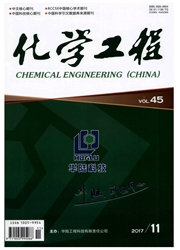

 中文摘要:
中文摘要:
采用玻璃珠作为纳米TiO2光催化剂载体,应用填充式光催化反应器,对低质量浓度甲醛进行光催化降解。研究不同甲醛质量浓度、反应温度、湿度下,甲醛转化率及反应速率变化情况。研究结果表明,0.095g光催化剂即可使20ms/m^3甲醛转化率达到61.3%。随甲醛质量浓度升高,甲醛转化率呈先降低后升高趋势,反应速率随质量浓度的升高而升高,基本符合Langmuir-Hinsherwood模型。随温度升高,甲醛反应速率降低,反应温度对低质量浓度甲醛影响较小。甲醛反应速率随湿度升高先下降,相对湿度高于30%时,基本不再变化。反应产物主要为CO2,温度高于115℃时,参与反应的甲醛可全部转化为CO2。
 英文摘要:
英文摘要:
A packed-bed photocatalytic reactor filled with glass beads coated decomposition of low mass concentration formaldehyde different inlet formaldehyde mass concentration, reaction The conversion and with nano-TiO2 was designed for reaction rate of formaldehyde at temperature and relative humidity were investigated. The results indicate that 61.3% of the formaldehyde is decomposed with 0.095 g photocatalyst for inlet formaldehyde mass concentration of 20 mg/m^3. The conversion of formaldehyde initially decreases and then increases with the increase of inlet formaldehyde mass concentration. The reaction rate increases with the increase of inlet formaldehyde mass concentration, which basically conforms to Langmuir-Hinsherwood Model. The reaction rate of formaldehyde decreases with the rise of temperature. The influence of temperature on the formaldehyde reaction rate was relatively weak at lower formaldehyde mass concentration. The formaldehyde reaction rate initially decreases and then levels off with increasing relative humidity. The formaldehyde reaction rate is quite similar when the relative humidity is above 30%. Carbon dioxide is the main product of the reaction. The formaldehyde in reaction can be completely converted into carbon dioxide when the temperature is higher than 115℃.
 同期刊论文项目
同期刊论文项目
 同项目期刊论文
同项目期刊论文
 期刊信息
期刊信息
